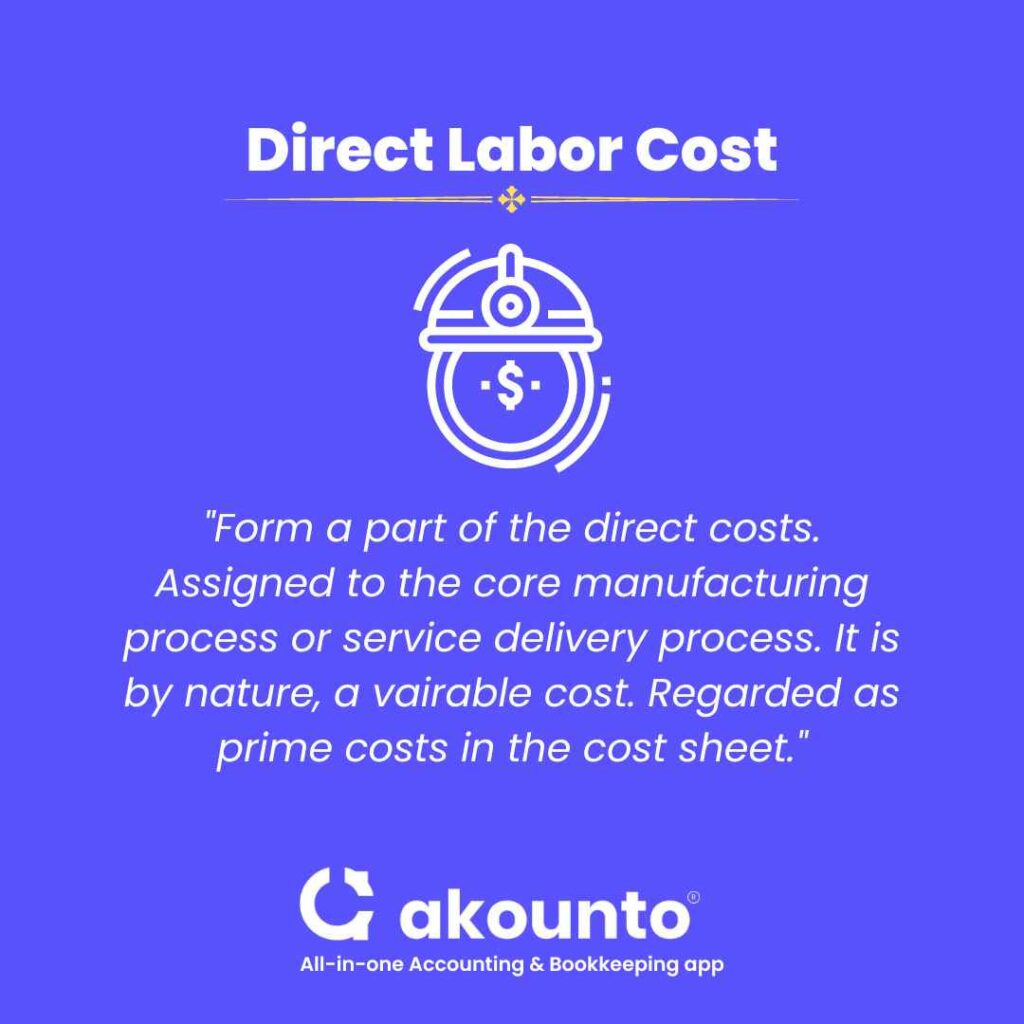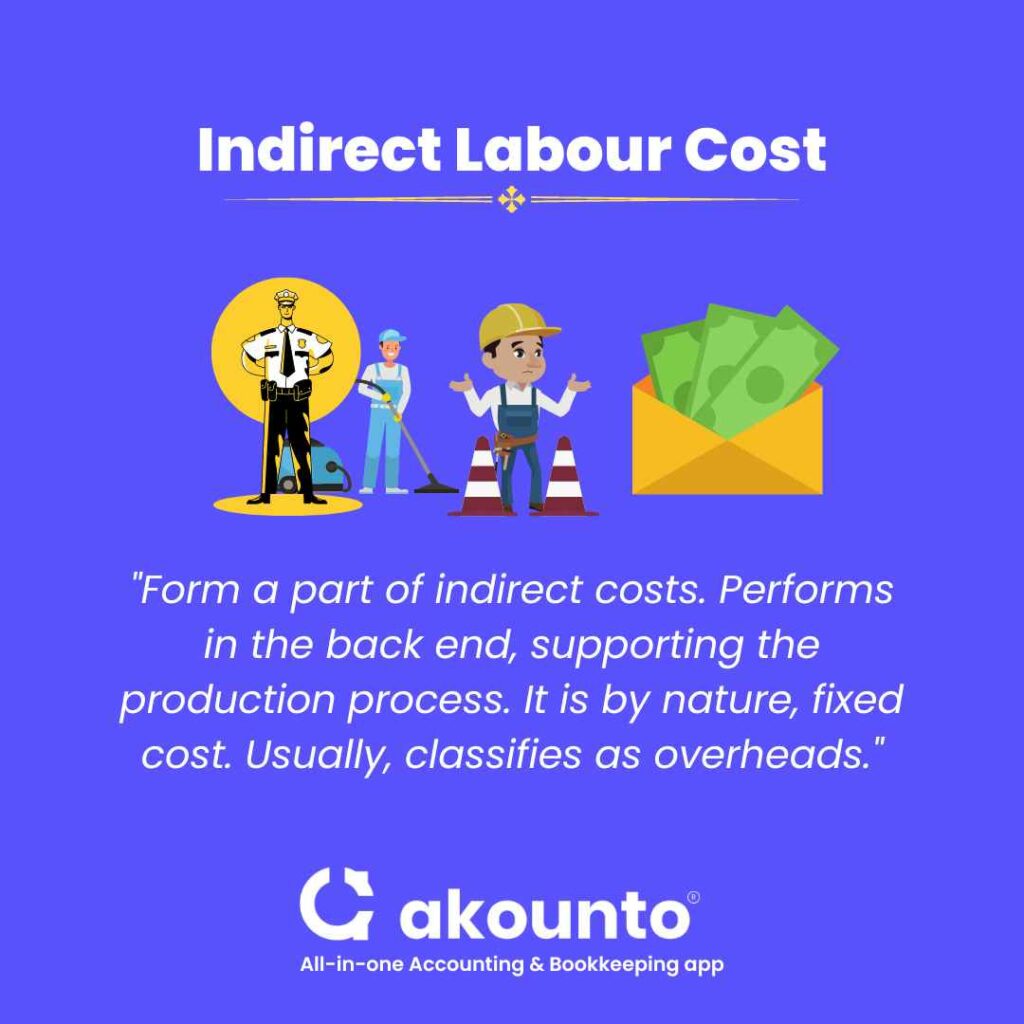Direct labor includes workers directly involved in core manufacturing operations, while indirect labor is engaged in auxiliary, supporting, and supervising roles.
Although management of direct labor costs and indirect labor costs is a standard procedure in larger businesses, it is proved to be crucial and profitable for small businesses too.
Small businesses should collect appropriate direct and indirect labor data to properly analyze the total labor costs across departments.
It is essential to control idle and inefficient labor to achieve the desired profit margin. Both direct labor costs and indirect labor costs are important for an entity’s optimum functioning.
While direct labor is essential for the production process, indirect labor is important in the functioning of the other departments. It can be said that direct labor is product specific while indirect labor is a support function.
Cost accounting pertains to the study of all types of costs, including direct and indirect labor costs in manufacturing a product or rendering core business services.
Importance of Labor Costs
Labor includes the workforce used by any company to assist, manage, supervise and monitor its manufacturing processes.
Labor is needed at every process stage, such as production, administration, sales, distribution, and henceforth. Even service businesses require the support of human resources for the smooth functioning of their business operations.
Direct labor costs and indirect labor costs are considered operating costs as they are necessary for the day-to-day activities of an entity.
Labor costs include
- Direct wages and salaries
- Overtime expenses
- Bonus and ex-gratia
- Medical benefits
- Retirement benefits
- Payroll taxes & training expenses etc.
Based on the organization’s size and the process level at which the workforce is employed, labor costs can be classified into direct and indirect. This bifurcation is done based on their traceability to the units produced.
Direct labor costs are also classified as production costs, while indirect labor costs are classified as non-production costs.
Small businesses need to track direct and indirect labor to ascertain the optimum utilization of resources and the impact of labor costs on the budgeted costs.
What is Direct Labor?

Direct labor is assigned to the core manufacturing process or service delivery process. Direct labor refers to all the workers or employees directly involved with the manufacturing process.
Direct labor costs can be traced to the specific production process, products, or services. Direct labor costs are a cost center and normally account for its productivity in terms of working hours, production per hour or day basis, etc.
Classification of Direct Labor Costs
Direct labor costs form a part of the direct costs. Direct costs vary with the change in the number of units produced by the entity. They are considered relevant when making specific business decisions as they cannot be avoided. Hence, direct labor cost is a variable cost.
They are considered relevant when making specific business decisions as they cannot be avoided.
Direct labor costs are often considered a cost driver for allocating overhead expenses under activity-based costing and are regarded as prime costs in the cost sheet. E.g., Supervising costs are allocated based on direct labor hours.
Direct Labor Cost Formula
The direct labor costs can be computed using the following formula:
Total direct labor cost = Total labor hours * Rate per hour
Total labor hours are the hours spent on producing a specific product. The entity must decide a particular rate beneficial for the entity and the employees. If the employees are happy with the payment, the entity can reduce the chances of employee turnover and thereby save recruitment and training expenses. In the service industry, there are billable hours.
Types of Direct Costs
Let us take two different scenarios for the classification of direct costs
Direct labor costs in the manufacturing process include costs incurred for :
- Assembly line workers
- Factory workers
- Machine operators
- Maintenance staff
- An employee performing quality checks at the production level
- Packing personnel
- Product managers
Direct labor cost in a service business is the wages paid to the employees who provide services to potential customers. Example :
- Beauty salon professionals,
- Accountants,
- Consultants in various firms
- Chef in restaurants etc.
Example: If person A is working for a manufacturing company and is engaged in assembly line activities, it will be considered direct labor since he is directly involved in the manufacturing process. The wages paid to person A will be a part of direct labor costs.
What is Indirect Labor?

Indirect labor performs essential activities like supervising and quality control, safety officer, compliance professionals, administration and selling, etc. but is not directly involved in the core activities of the entity. Hence they are not a part of the direct costs.
Indirect labor performs in the back end, supporting the production process. Although they are necessary for the company, their role is not crucial for the direct development of a particular product.
Indirect labor costs are otherwise called overheads, the allocation of which is done based on various cost drivers. Cost driver refers to any activity which triggers the incurrence of a cost. The cost drivers can be machine hours or direct labor hours.
Indirect labor costs are otherwise called overheads, the allocation of which is done based on various cost drivers.
Classification of Indirect Labor Costs
Indirect labor costs are generally classified as fixed costs. But sometimes can also be classified as a variable cost based on the circumstances.
The expenses incurred to hire, train and supervise the indirect labor are added to the prime costs to arrive at the factory costs.
Analysis of indirect labor costs helps companies to make appropriate planning and budgeting decisions.
Indirect Labor Cost Formula
Let us take the cost driver as the number of labor hours.
Step 1: Compute the absorption rate
Absorption rate = Total overheads cost / Total labor hours
Step 2: Allocation of overhead costs
Indirect labor cost = labor hours spent on specific product* absorption rate
Various methods have been prescribed for the computation of absorption rate. Management may opt for any of the ways that suit its convenience.
Indirect labor cost types and example
- Production Supervisor
- Purchasing staff
- Accountants
- General managers
- Selling & distribution executives
- Security personnel
- Administrative staff etc.
Example: Services provided by the accountant in a consulting firm are considered indirect labor. Though they perform essential activities like preparing financial reports, their services do not directly relate to the provision of consulting services. Therefore, their classification differs with their traceability to the product.
Classification into Direct and Indirect Labor
The classification into direct and indirect labor differs from one organization to another. Direct and indirect labor classification is important for making the right accounting decisions and controlling cost and resource optimization.
Let us consider two entities operating in different fields: a manufacturing concern and an accounting firm. The analysis shall be as follows:
| Employee position | Manufacturing business | Services – Accounting Firm |
| Security personnel | Indirect labor | Indirect labor |
| Accountants | Indirect labor | Direct labor |
| Quality control personnel | Indirect labor | Indirect labor |
| Assemblyman | Direct labor | Not applicable |
| Consultants | Indirect labor | Direct labor |
Calculating Indirect Labor Costs
Example: Aay Bee Cee Inc. engaged in the production of mobile phones, has three production departments and two service departments. The expenses for these departments are as follows:
| Production Departments | Amount ($Rs.) |
| Dept A | 30,000 |
| Dept B | 26,000 |
| Dept C | 24,000 |
| Service Departments | |
| Accounts | 13,000 |
| Canteen | 11,000 |
The following information has also been provided
Department A Department B Department C
| Dept A | Dept B | Dept C | |
| Labor hours worked | 20 | 15 | 15 |
Solution
Allocation of overheads is as follows:
Step 1: Absorption rate ( formula has been given above )
Absorption rate = (13,000+11,000) /50 = Rs. 480 / labor hour
Step 2: Allocation
| Basis of allocation | Dept A | Dept B | Dept C | |
| Direct labor cost (A) | Traceable to the product | 30,000 | 26,000 | 24,000 |
| Indirect labor cost (B) | Labor hours worked | 9,600( $ 480*20) | 7,200($480*15) | 7,200($ 480*15) |
| Total cost (A+B) | $ 39,600 | $ 33,200 | $ 31,200 |
Direct vs indirect labor cost: Key Differences (TABLE)
| Direct labor | Indirect labor | |
| Meaning | Directly involved in the production of the product. | Indirect labor is crucial labor but not directly involved in the production. |
| Work place | They generally work in the factory premises. | They work across various departments in the organization. |
| Identifiability | Can easily be identified and allocated to the product | Cost is apportioned on some appropriate basis. |
| Variability | These costs vary with the change in the number of units. | These costs may or may not vary with the change in the number of units. |
| Presentation | These costs form a part of the prime cost. | These costs form a part of the factory overheads (selling and administrative overhead), which are added to the prime cost to ascertain the works cost. |
| Employee turnover | When the demand for a product decreases, these costs can potentially be reduced. | However, indirect labor costs remain fixed in most cases and are incurred irrespective of the demand. |
| Cost Management | Direct labor engaged in the factory premises requires basic skills. Therefore these labor are available at lower costs. | Whereas indirect labor, whose services are required in other departments relatively, needs more skills. Hence, their recruitment requires more excellent monetary investment. |
| Examples | Assembly man, machinists etc | Accountants, managers, distributors etc. |
Final Word
The issue of direct vs. indirect labor depends upon the business and industry type. Accounting for direct and indirect labor is essential because they contribute to the final cost of production and impact the pricing decision.
Optimizing direct and indirect labor costs is more than just cost control. Minimizing production costs helps businesses keep prices competitive while maintaining profit margins.
Direct labor cost and indirect labor cost is one such quintessential fields for a small business to optimize their manufacturing process. For similar cost and management accounting knowledge, visit Akounto Blog and keep yourself updated.
FAQs
Some examples of indirect labor include Office manager, clerks, and other employees, legal adviser, drivers of delivery vans, cost accountants and financial accountants, quality control staff, packers and dispatch staff, and administrative personnel who support production but do not directly engage in the manufacturing process.
Examples of direct labor include assembly line workers, machine operators, construction workers, and any personnel directly involved in the production or provision of goods and services.
Yes, factory labor is direct labor who is directly working on the assembly line or involved in repairing manufacturing, and production activities. Indirect labor comprises roles supporting production indirectly, such as supervisors and maintenance staff.
Yes, a factory superior is an indirect labor. While they oversee and manage production activities, they do not directly engage in the manufacturing process itself. Instead, they provide supervision, guidance, and support to the workers involved in direct labor activities.В
Engineers can be either direct or indirect labor depending on their specific roles. When engineers are directly involved in manufacturing processes, they are considered direct labor, while those supporting production indirectly, such as design or quality engineers, fall under indirect labor.




